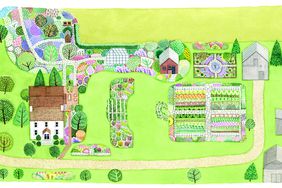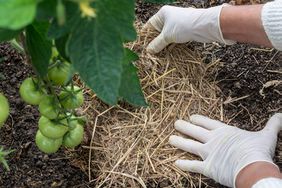:max_bytes(150000):strip_icc()/GettyImages-453730035-1a2eaf2abbe34d2ba33ac82f0b5cc273.jpg)
typo-graphics / Getty Images
Gardening season is just around the corner. For fun tips and homemade tricks to maximize your on-farm garden, check out these 10 reader-submitted ideas from Living the Country Life.
Seed cart
:max_bytes(150000):strip_icc()/100682059_seedcartpreview-1fca27abd91f4729a922a62adeb5a717.jpg)
Living the Country Life
I built a cart on wheels to start my seeds in spring. It is 5 feet long and 2 feet wide. It has a shelf on the bottom for storage and a shelf on top for plants. It has two uprights (each is 2 feet high and 2 inches wide) 1 foot apart on each end. I drilled 15 1- inch-diameter holes in each of the four uprights. I used two metal rods to hang two florescent lights. I move the lights up as the plants get taller.
– R.O., Ohio
Straw garden
:max_bytes(150000):strip_icc()/101921310strawgarden-b54651fd6dc341a285a41f8b82ed9b54.jpeg)
Living the Country Life
Our home did not have good soil for planting a summer garden, so we planted our tomatoes in bales of wheat straw. We had to water more often, but our kitchen was supplied with a bounty of tomatoes.
– H.L., Georgia
Vine-ripened tomatoes
:max_bytes(150000):strip_icc()/tomatovine-bfe1f0dcd9f9429bac932a87c6dedeb4.jpg)
Living The Country Life
Continue to vine-ripen an heirloom tomato, even after the delicate skin begins to crack, by enveloping it in a clear sandwich bag. Gently ease the bag up over the fruit from below, then close the top around the stem with a twist tie.
– D.B., West Virginia
Bye-bye bugs
:max_bytes(150000):strip_icc()/DirtDevilScorpionQuickFlipCordedBaglessHandheldVacuumSD20005RED-5908a9845f9b58647044faa7.jpg)
We found an effective, pesticide-free method to get rid of the stink bugs that ruin our tomatoes. We suck them up with a handheld vacuum, then dump them into a bucket of soapy water to kill them.
–R.L., Texas
Composter
:max_bytes(150000):strip_icc()/101569753composter-18d274aa00514947816eba00f7937a0e.jpeg)
Living the Country Life
I developed a composter using a 55-gallon plastic drum. I cut off the bottom, drilled eight holes about 2 inches in diameter, drilled half-inch holes through four pieces of PVC pipe for ventilation, and slid the pipes into the drum holes.
– N.S., Michigan
Use a driveway alarm
:max_bytes(150000):strip_icc()/102035455drivewayalarm-3baf8182f9074b59a1509f694d4f7f2f.jpeg)
Living the Country Life
To keep pests like raccoons, opossum, birds, and deer out of your garden, grape vines, and orchards, purchase a wireless driveway alarm. Put the re-ceiver in a plastic bag. When an animal walks into the space, the alarm rings and scares it away.
– J.B., Alabama
Make them sneeze
:max_bytes(150000):strip_icc()/102058434makethemsneeze-9b918f1d52bc4a13a133c290467ab01e.jpeg)
Living the Country Life
To keep ground critters like skunks away, grind up equal parts of black peppercorns and whole cloves, and mix in equal parts of ground cinnamon and cayenne pepper. Mix thoroughly, place powder in a shaker can, and sprinkle a swath every few months.
– E.B., West Virginia
Tomato ladder

I had an old wooden ladder that wasn’t safe to climb anymore. So I spaced tomato plants between the rungs and staked the ladder up on each end to the height I needed. It’s easy to hoe around and under.
– P.G., Michigan
Garden ID
:max_bytes(150000):strip_icc()/sharpie-30d666d2e16a4882b9279d022726e27e.jpg)
Imogenphoto/ fStop/ Getty Images
To identify the plants in my perennial beds, I write (with permanent marker) all the pertinent information on both the blade and the handle of a plastic knife. The blade then gets pushed into the ground; the information on the blade hasn’t washed or faded in three years.
–M.M, Illinois
Potato baskets
:max_bytes(150000):strip_icc()/plastic-laundry-baskets-170-x-170-56a58df25f9b58b7d0dd67e7.jpg)
Digging potatoes with a shovel or pitchfork can be time consuming and injure the potatoes. So now I plant them in small laundry baskets full of compost. To harvest, I simply dig up the baskets.
–A.S, New York






